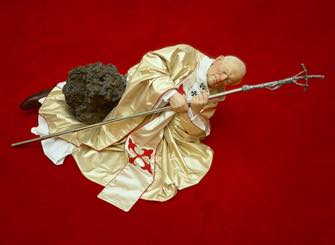Here’s an excellent excuse for an excursion to the seaside: François Pinault, French billionaire businessman, art collector and father-in-law of Salma Hayek (choose your own order of importance) is showing part of his extensive collection of contemporary art in the town of Dinard, on the Brittany coast.
After his attempts to build a permanent home for his collection just outside Paris were frustrated by the snail’s pace of French bureaucracy, Pinault turned to the more welcoming city of Venice and now has two sites there: the Palazzo Grassi and the just-opened Punta della Dogana. He also lends works from his 2,500-piece collection for exhibitions elsewhere; part of it is currently on show in Moscow, and now in Dinard. Why Dinard? Simply because the mayor’s office had the bright idea of asking Pinault, a native of Brittany who owns a home in the town, and he said yes. The show offers the city a way to attract more visitors, gives bronzed beach-goers a taste of culture and lets Pinault bring more artworks out of storage and into the light of day.
A glance at the list of artists featured, including many of the stars of contemporary art – Damien Hirst, Maurizio Cattelan, Cindy Sherman, Ed Ruscha, Takashi Murakami – had me thinking “been there, done that,” so I was pleasantly surprised to find mostly works that I had never seen before handsomely displayed in Dinard’s Palais des Arts, right in the center of town near the beach. And the quality of most of these works explains why these artists are stars – anyone who visited “La Force de l’Art,” the lackluster show of French contemporary art held recently at the Grand Palais in Paris, will see the difference.
The show, called “Qui A Peur des Artistes?,” presents a “portrait” of Pinault’s collection, with some 60 works by 30 artists. While it is something of a hodgepodge of different periods, styles and themes, it offers a sort of mini-history of contemporary art that makes a fine primer for the uninitiated, starting with minimalists like neon-light artist Dan Flavin and all-black-canvas-painter Pierre Soulages. Another room features contemporary artists’ tributes to their predecessors: Yan Pei-ming’s stunning monumental black-and-white portrait of Giacometti (2007), for example, and Charles Matton’s dollhouse-like re-creations of artists’ studios. Witty French artist Martial Raysse, who works in an amazingly diverse variety of media and styles, has a whole room to himself.
War, violence and rebellion get a whole room, too, though I’m not sure why Cindy Sherman’s elaborate photographic self-portraits in different guises were included here. No such doubt about Adel Abdessemed’s video “Usine” (2009), which shows what happens when tarantulas, rattlesnakes, scorpions and other predators are thrown into a pit together with pacific creatures like mice and bunny rabbits (sensitive souls and PETA members abstain) and nature takes its course.
A section on urbanism features Mike Kelley’s colorful fantasy sculptures of cities in glowing resin and Julie Mehrethu’s large painting, “Black City” (2007), which might be described as Calder meets Pollock in outer space.
The final room, whose theme is the fear of death, is the most spectacular. Here we find the much-maligned (because so successful) Damien Hirst in fine form with “The Kiss of Death,” a formaldehyde-preserved bull’s heart pierced by a silver dagger and wrapped in barbed wire, and three other pieces, including one of his butterfly paintings. The standout here, however, is Maurizio Cattelan’s “La Nona Ora,” a realistic, life-size sculpture of Pope John Paul II felled by a meteorite.
The show opens and closes with another highly realistic sculpture: Paul McCarthy’s crowd-pleasing “Mechanical Pig” (2005). The anatomically correct silicone sow is irresistible to watch as it lies sleeping atop its life-support machine, moving and breathing as it dreams.
Dinard, a favorite 19th-century resort of wealthy Britons, who built marvelous villas along the coast for their summer holidays, still retains much of its charm. It holds an annual festival of British film in early October.
© 2009 Paris Update
Favorite
